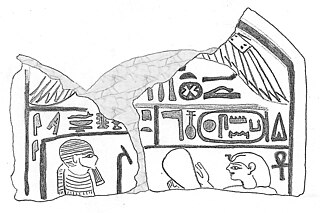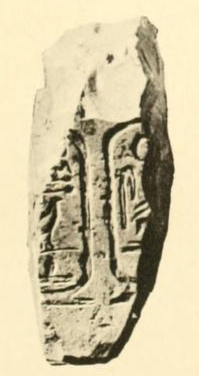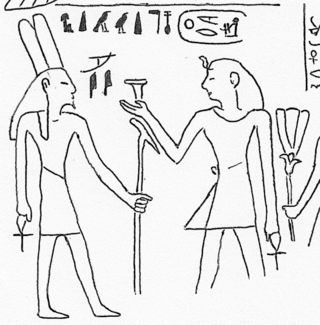
Merneferre Ay was an ancient Egyptian pharaoh of the mid 13th Dynasty. The longest reigning pharaoh of the 13th Dynasty, he ruled a likely fragmented Egypt for over 23 years in the early to mid 17th century BC. A pyramidion bearing his name shows that he possibly completed a pyramid, probably located in the necropolis of Memphis.

The Sixteenth Dynasty of ancient Egypt was a dynasty of pharaohs that ruled the Theban region in Upper Egypt for 70 years.

Merhotepre Sobekhotep was an Egyptian king of the late 13th Dynasty during the Second Intermediate Period.

Semenkare Nebnuni is a poorly attested pharaoh of the early 13th Dynasty during the Second Intermediate Period. He is mainly known for his position in the Turin King List.
Sankhenre Sewadjtu was the thirty-fourth pharaoh of the Thirteenth Dynasty of Egypt during the Second Intermediate Period. Sewadjtu reigned from Memphis, starting in 1675 BC and for a period of 3 years and 2 to 4 months.

Sewadjare Mentuhotep is a poorly attested Egyptian pharaoh of the late 13th Dynasty, who reigned for a short time c. 1655 BC during the Second Intermediate Period. The Egyptologists Kim Ryholt and Darrell Baker respectively believe that he was the fiftieth and forty-ninth king of the dynasty, thereby making him Mentuhotep V. Thus, Sewadjare Mentuhotep most likely reigned shortly before the arrival of Hyksos over the Memphite region and concurrently with the last rulers of the 14th Dynasty.

Sehetepibre Sewesekhtawy was an Egyptian pharaoh of the 13th Dynasty during the early Second Intermediate Period, possibly the fifth or tenth king of the Dynasty.
Iufni was an ancient Egyptian pharaoh of the 13th Dynasty during the Second Intermediate Period.
Nedjemibre was an ephemeral Egyptian pharaoh of the 13th Dynasty of Egypt during the Second Intermediate Period reigning c. 1780 BC or 1736 BC.

Merdjefare was an ancient Egyptian pharaoh of the 14th Dynasty of Egypt during the Second Intermediate Period c. 1700 BC. As a king of the 14th Dynasty, Merdjefare would have reigned from Avaris over the eastern Nile Delta and possibly over the western Delta as well.

Seankhenre Mentuhotepi was an ancient Egyptian pharaoh during the fragmented Second Intermediate Period.
Merkawre Sobekhotep was an Ancient Egyptian king during the Second Intermediate Period.

Mersekhemre Ined was a pharaoh of the late 13th Dynasty, possibly the thirty-fifth king of this dynasty. As such he would have reigned from Memphis over Middle and Upper Egypt for a short time either during the early or mid-17th century, from 1672 until 1669 BC or from 1651 until 1648 BC. He may be the same king as Mersekhemre Neferhotep II.

Nerikare was an Egyptian pharaoh of the 13th Dynasty during the Second Intermediate Period.

Menkhaure Snaaib was an Egyptian pharaoh during the Second Intermediate Period between the Middle Kingdom and New Kingdom at the end of the Middle Bronze Age.

Wazad was an Egyptian pharaoh during the Second Intermediate Period. According to the Egyptologists Kim Ryholt and Darrell Baker, Wazad was a member of the 14th Dynasty of Egypt reigning c. 1700 BC. As a king of the 14th Dynasty, he would have reigned from Avaris over the eastern Nile Delta and possibly over the western Delta as well. The Memphis-based 13th Dynasty reigned over Middle and Upper Egypt at the same time. Alternatively, according to Jürgen von Beckerath and Wolfgang Helck, Wazad was a ruler of the 16th Dynasty and a vassal of the Hyksos 15th Dynasty. This view is debated in Egyptology, in particular because Ryholt and others have argued that the 16th Dynasty was an independent Theban kingdom rather than a vassal dynasty of the Hyksos.

Sekhemrekhutawy Khabaw was an Egyptian pharaoh of the early 13th Dynasty during the Second Intermediate Period.

Sewahenre Senebmiu is a poorly attested Egyptian pharaoh during the Second Intermediate Period, thought to belong to the late 13th Dynasty.

Merkheperre was an Egyptian pharaoh of the late 13th Dynasty of Egypt during the Second Intermediate Period reigning some time between 1663 BC and 1649 BC. As such, Merkheperre would have reigned either over Upper Egypt from Thebes or over Middle and Upper Egypt from Memphis. At the time, the Eastern Nile Delta was under the domination of the 14th Dynasty.

Sekheperenre was an Egyptian pharaoh of the 14th Dynasty of Egypt during the Second Intermediate Period. According to the Egyptologists Kim Ryholt and Darrell Baker, Sekheperenre was the twenty-second king of the dynasty; alternatively, Jürgen von Beckerath sees him as the seventeenth ruler. As a king of the 14th Dynasty, Sekheperenre would have reigned from Avaris over the eastern Nile Delta and possibly over the western Delta as well.
















